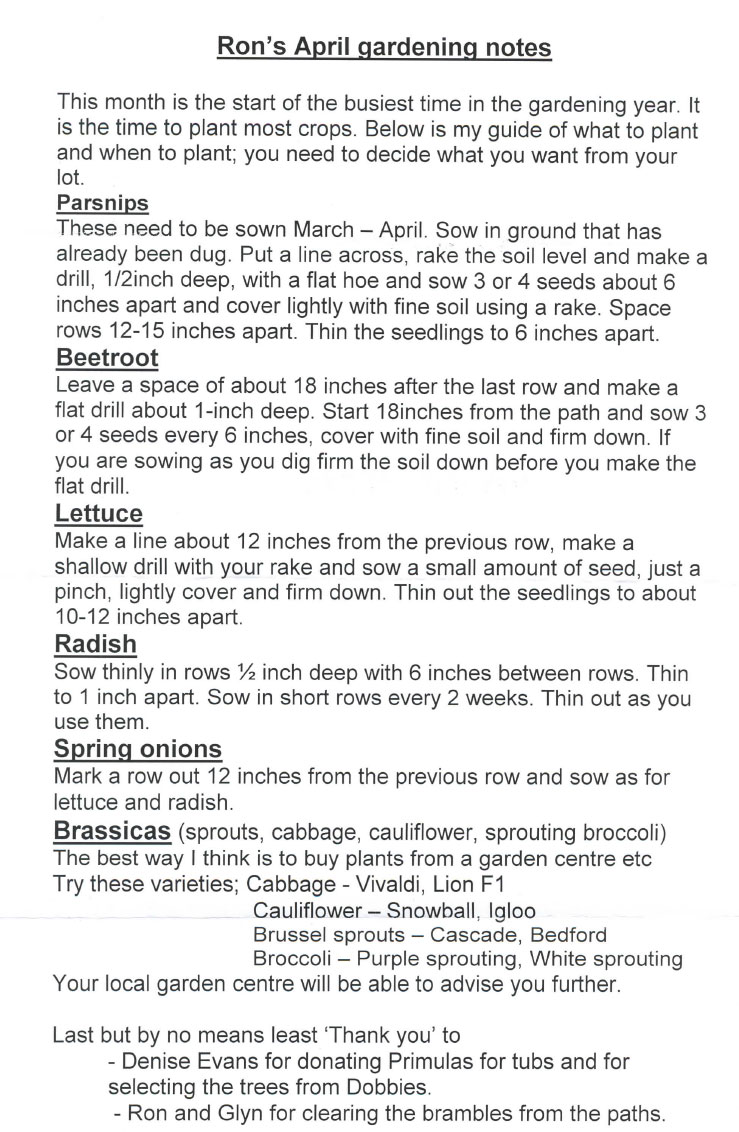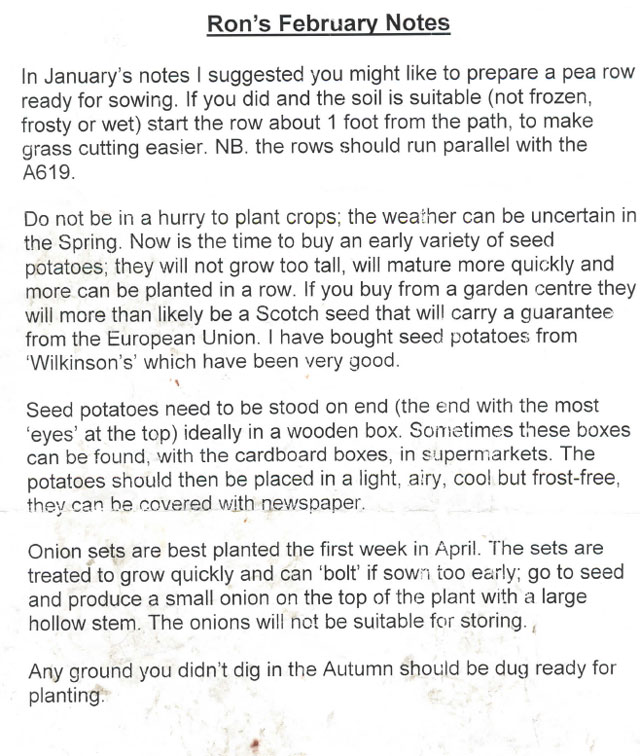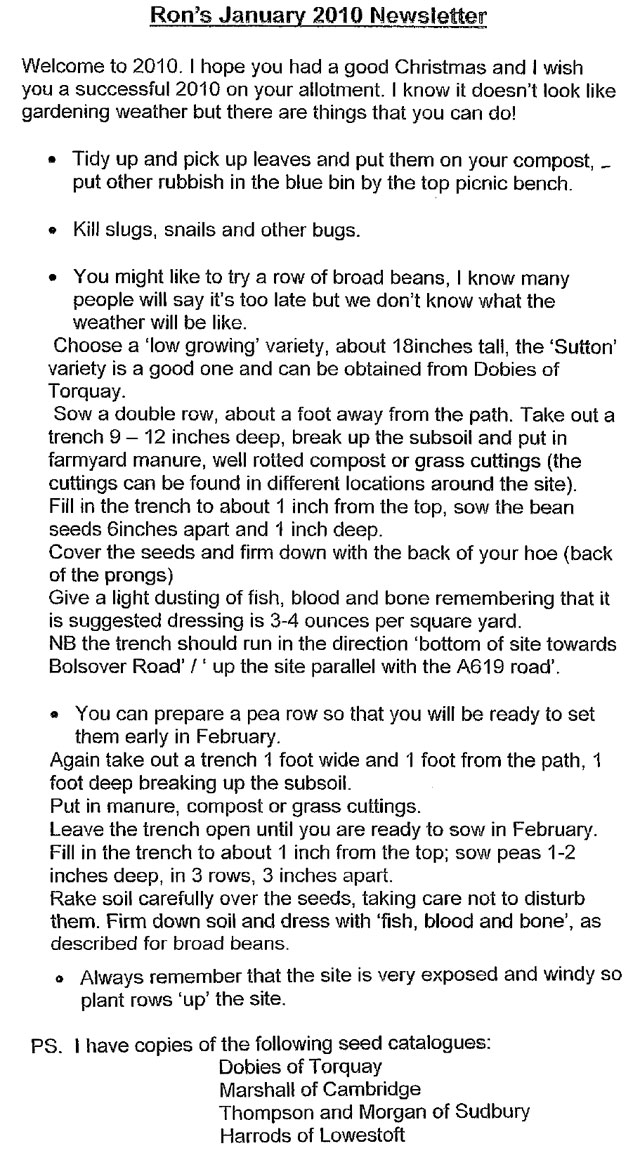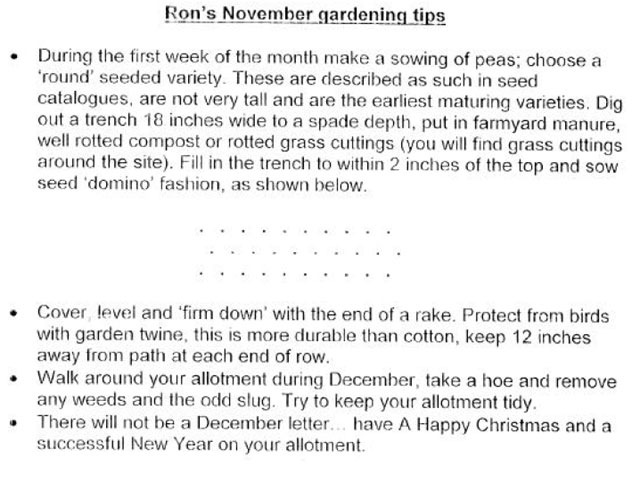

MENU |
|
|
|
|
Ron's Reminders
Ron’s Gardening Notes
Hello Everyone, The weather during April, especially for gardeners, has been good. You should, by now, have planted everything you want to grow except spring cabbage, brussels sprouts, winter and next spring cabbage and cauliflowers. If you want to grow calabrese now is the time to plant. Check at the garden centre for availability of plants, it is too late to grow your own plants from seed. If you do grow calabrese, plant in rows about 2 feet apart, leaving 2 feet between plants, starting 2 feet from the path and finishing 2 feet from the other end. Plant firmly using your dibber. If you haven’t planted all your potatoes yet do this immediately, it is now urgent. You can sow peas (I described how in last month’s newsletter). Continue sowing salad crops: lettuce, radish, spring onions and beetroot. Sow runner beans seeds now, 2 beans to each cane / 1 plant to each cane. Continue to hoe, this will keep the weeds under control and deter slugs etc. Perhaps more importantly, it will help to retain moisture. I hope you have a successful year.
|
|||||||||||||||||||||
Ron’s Newsletter – April 2011
The sowing of any seed should be done this way. The spacing of seed and distance between rows will need to be adjusted; onions, beetroot, lettuce, radish and spring onions rows need to be about 12 inches apart to allow for hoeing and always start and end rows 12 inches from the path.
. . . . . . .
Plant early cabbage and cauliflower 12inches apart.
Unless we have a prolonged warm dry spell you should not need to water. Brussel sprouts can be planted later in the month. Plant as above, start and end rows 3 feet from paths with 2 feet between plants. Remember the firmer the ground the harder the sprout. A good sprout should be the size of a walnut and as hard. Following the interest created by the potato trial last year we are going to grow some garlic. Garlic is a very popular addition to many of our recipes, but how many people have seen it growing?
Allow 12 inches between every row and 6 inches between each garlic corm and onion set.
|
|||||||||||||||||||||
Ron’s Newsletter - February 2011 Hello everyone, I hope you have enjoyed the festive season. At this time of the year keep your allotment tidy; remove weeds with a flat hoe and dispose of snails and slugs! If the weather is ‘fine’ and the ground not frozen or too wet you can finish digging.
Following the interest generated by the potato trial last year, we are going to have a parsnip trial this year! |
|||||||||||||||||||||
Ron's News Letter - July 2010
There is not much you can sow this month except salad crops; lettuce, radish, spring onions. Hoe when ever you can, this will keep your allotment tidy and weed free, but more importantly will help moisture retention and make life difficult for pests like slugs and snails. Water only when absolutely necessary. Start thinking about next year and what you want to grow. You might have cleared away a crop. You might like to grow a few cabbage and cauliflowers which mature from late December to mid April. Most of the varieties I used to grow are no longer listed, but if you go to a garden centre, they will be happy to suggest varieties and give you advice. Remember you will need only about six cabbage or cauliflower plants - Good Luck.
Our thanks go to: Glyn for doing such a good job on Laburnum Walk. Denise and Dobbies for the bedding plants Joy for the donation Gerry for mowing Fundraising: Would you be willing to donate plants / produce / cakes etc to sell once a month or at an Open Day? We need to raise money to help defer the costs of running the site and need your help to do it. Please get in touch with Rita or Ron. Additional notes: I have left copies of all the seed catalogues I received for 2010 at Mastin Moor Miners Welfare Club, with Norman Hadley. A jacket has been found. Anyone wish to claim it? It is with Rita. |
|||||||||||||||||||||
Ron's Gardening Notes June 2010 Watering
All the water used on the site comes from a metered supply and costs us money, so we need to consider carefully how and where we use it. According to some ‘experts' the amount of water required by different plants is considerable. Had I followed their recommendations on watering when I had 750 square yards of allotment, I would not have had time to do anything else! However, when I first started gardening (it was along time ago!) , an experienced gardener gave me some good advice; he told me to water with my flat hoe. I found out later what he meant. Soil is not a solid mass, but contains thousands of minute passages to the surface. These capillary tubes are about the size of a human hair. When you hoe you temporarily close them off so that moisture cannot evaporate as quickly. Apart form this, you also chop off weeds and either kill them or, if they do come again, at least weaken them. It also makes it more difficult for weed seeds to germinate. That said, some things do need watering: • Brassica Plants e.g. cabbage, cauliflower, Brussels sprouts, calabrese Make a hole with a dibber (I can lend you one, if needed), fill the hole with water, put the plant in, allow the water to soak in, then firm the soil and give a little more water. All brassicas need to be firmly planted. Remember ~ “The firmer the ground, the harder the sprout!” • Peas When pods start to develop from the flowers, water well until you notice the pods start to fill (i.e. have peas in them). Then stop watering. • Runner Beans Water often when flowers start to form (daily in the morning if possible). Carry on watering until flowering stops. Give enough water to keep the soil damp, but not saturated. • Plants in Containers All you need to do is make sure that they don't dry out; remember more plants are killed by over-watering than are killed by under-watering. There are some notes taken from 2 of my gardening books at the end of this newsletter; I hope you find them interesting. June Notes
Although it is a busy month in the garden, there is not a lot of sowing to be done, but you can still make regular sowings of salad crops ~ lettuce, radish & spring onions. If you have a space going spare, or you have already cleared a crop, you might like to grow a few winter / spring maturing cauliflower. Plant them as you do other brassicas ~ in rows staring about 18 inches from the path, leaving about a foot between plants, firm in well, give a dressing of fish, blood & bone. The varieties I used to grow are no longer in the catalogue, but one suggested variety of cauliflower for winter / spring maturing is PRESTIGE, or an equivalent, I am sure that the staff at garden centres will advise you if you ask. Keep hoeing whenever you have time, it is well worth it. You will keep your plot tidy and weed free, as well as helping with water retention. Enjoy your allotment while it is growing, that is what makes all the effort worthwhile! Sad To Say: Alan Wood has suffered vandalism to his plot. It has been suggested that this attack was aimed at the plot rather than Alan himself. Sadly, no allotment site is immune to the present ills of society, but if we keep on keeping on, such mindlessness will not be rewarded. In the meantime, we hope that everyone will support one another if they see an opportunity to help out, put things right, share plants et cetera. If you have any information that would help, or if you do see anything untoward please report it to the police. Reminders:
Please help to keep the allotment and gardens tidy by clearing up after yourselves, adding anything that will compost to the heaps. If you find anything that will not compost then please try to dispose of it responsibly. Bricks, stones and bits of wood can be tucked under hedge bottoms out of sight and will provide cover for insects. If there is anything that you cannot get rid of yourself, please leave by the bottom gate (the Worksop Road one which is never opens contact us and will see about taking it to the tip. Unless you are disabled, please do not park on the path at the entrance from Worksop Road. Vehicles parked there do make it difficult for pedestrians to pass, especially anyone with a wheelchair or buggy and the surface is not really suitable for cars. Our Thanks Go To: • Ron & Glynn for all their hard work keeping the Community Garden looking so well, planting trees, and removing rubbish. • Gerry for mowing the grass. • Steven B. for mowing around the allotments. • Denise for her donations of plants and trees. • Alan Swift for removing the wood that had been thrown on to the wildlife areas. Dates for your diary:
Committee meetings are planned to take place between 7.30 and 9.00 on: • Monday 5 th July • Tuesday 5 th August • Monday 6 th September Please come along to help the working parties on the Community Garden (and bring a friend!) planned for 10.00 to 12.00 on: • Saturdays 10 th July • Saturday 14 th August • Saturday 11 th September
Watering
This is one of the most important tasks in the cultivation of plants under glass, and is also frequently necessary with plants outside, if they are not well established, or the weather is very dry and hot. One of the commonest causes of failure with indoor plants is the application of water too frequently and an inadequate quantity. It is absolutely essential that the soil in the seed box, pan, pot, or greenhouse border should be moistened right through every time it is watered. Watering by immersion is recommended in the case of seed-pans and particularly difficult plants; by this means the soil is thoroughly moistened and the foliage is kept dry. Over-watering can be as damaging as under-watering for pot plants, as it drives out the air from the soil and drowns the roots. Good drainage and a porous potting compost will help to prevent these evils, but a generally safe rule, is to apply water only when soil begins to get dry, and then to give sufficient to soak the soil right through. Outdoors there is less danger of doing damage by over-watering. Most crops and ornamental plants benefit from some extra water in dry weather, and when in doubt, it is probably wise to err on the side of giving too much than too little. from Percy Thrower's Encyclopaedia of Gardening Absorption of Water and Nutrients from the Soil
The taking up of water from the soil is an important function of plant roots. Only the finer fibrous roots are involved. These are normally present in large numbers and spread through the soil in all directions. Near the tips of such young rootlets are the root hairs. These pass between the minute grains of which a soil is composed and come in close contact with a film of moisture which usually surrounds the soil grains. Soil `water' is normally a weak solution of various salts and the water is absorbed into the root by the process called `osmosis'. When two solutions are separated by a membrane through which water can pass, but which holds back the dissolved salts, then water moves into the stronger solution. This process will continue as long as the difference in solution strength is maintained. The cell sap in the root hairs is a stronger solution than that in the soil; hence water moves into the plant. From the root hairs the water passes from cell to cell, into the conducting channels of root and stem and then into the leaves. However, we know that the process is not as simple as this, for salts are also taken up by the roots. Although the cell membranes do act osmotically, they are leaky membranes and growing cells are able to accumulate nutrient salts against a concentration gradient. To achieve this, the young root cells must use chemical energy which they do by breaking down sugars contributed by the leaves. Thus for perfect health, root tips and leaves are completely interdependent - both are essential for the nutrition and functioning of the other. Well-grown plants sometimes develop an internal root pressure manifest by the exudation of droplets from the vein-endings of the leaves, but this is usually of minor importance in determining water and mineral uptake. Evaporation of water from leaves may proceed in varying degrees under all conditions except when the surrounding air is saturated with water vapour. This process tends to lower the leaf temperature and without this cooling effect the foliage could sometimes be scorched by the sun's rays during hot weather. Hence we have a picture of water being absorbed by the roots and moving in a regular current or stream through the plant, most being lost by evaporation through the stomata. This stream provides not only the water requirements of the plant but also carries in solution the essential chemical nutrients from the soil to all the organs of the plant. Water
Ninety per cent or more of a soft, herbaceous plant may consist of water, and it is water which keeps the soft young cells in the leaves and stems turgid or plump and extended. But if water is in short supply this cell turgidity is lost so that the leaves droop and wilt while the stems of herbaceous plants become limp. Should water shortage be prolonged the plant may wither and die. Just as plants vary in their light and temperature requirements there are also wide differences in their water needs. Moreover, plant adaptations in relation to water supply are most pronounced. Those growing in or near water are called `hydrophytes' (e.g. water lily). Most show rapid growth, frequent branching and over-winter by buds, tubers, or rhizomes. At the other extreme, a large number of species, called 'xerophytes', have adapted their form and structure to conditions of water shortage. This usually takes the form of a reduced leaf area, as with broom and gorse. Under desert conditions a plant may survive without water for months or even years. Some plants (species of cactus) may disperse with leaves altogether, but their fleshy stems are not only very suitable for water storage but also act as leaves. Intermediate between the hydrophytes and the xerophytes are the great majority of ordinary plants called ‘mesophytes'. These also show adaptations which reduce water loss. Thus verbascums produce a mass of hairs on their leaves for this purpose, and various evergreens, such as laurel, have thick leaves with a waxy surface which tends to restrict water loss in transpiration. Unless plants receive adequate water their growth may be checked or prevented. Too much water in the soil can also be bad for plants because the excess water replaces air and the roots become waterlogged. from Complete Gardening Edited by C E Pearson |
|||||||||||||||||||||
 |
|||||||||||||||||||||
 |
|||||||||||||||||||||
 |
|||||||||||||||||||||
 |
|||||||||||||||||||||
 |
|||||||||||||||||||||
 |